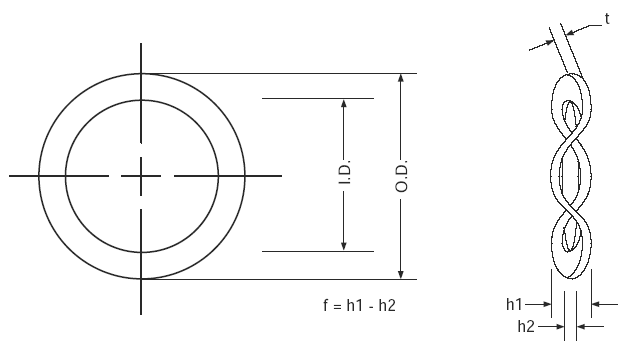Related Resources: calculators
Wave Washer Design Formula and Calculator
Spring Design and Engineering Equations and Calculators
Wave Washer Design Formula and Calculator
Wave washers are used to apply moderate thrust loads when radial space is limited. A typical wave washer is shown in Figure 1.
Figure 1 - Typical Wave Washer

Preview: Wave Washer Design Calculator
The stress on a curved washer is:
Eq. 1
S = (0.3 · π · EM · f · t · N2) / (D)2
Eq. 1a
D = ( OD + ID ) / 2, in (mm)
Where:
S = Bending stress, lbs/in2, (N.mm2)
EM = Modulus of Elasticity, lbs/in2, (N.mm2)
f = washer deflection, in (mm)
t = washer thickness,
in (mm)
N = Number of waves
D = Mean diameter, = ( OD + ID )/2
,
in (mm)
OD = outside diameter, in (mm)
ID = Inside diiameter, ,
in (mm)
The failure rate of a curved washer is determined using the following equation:
Eq. 2
λSP = λSP,B · ( S / Ts )3 · Ccs · CR · CM
A generalized equation that adjusts the base failure rate of a curved washer considering anticipated operating conditions can be established:
Eq. 3
λSP = λSP,B · CE · Ct · CD · CY · Cf · CNW · CCS · CR · CM
where:
λSP = Failure rate of torsion spring, failures/million hours
λSP,B = Base failure rate for torsion spring, 14.3 failures/million hours
CE = Multiplying factor which considers the effect of the material elasticity modulus on the base failure rate
Eq. 4
CE = ( EM / 28.5 x 106 )3
Ct = Multiplying factor which considers the effect of the material
thickness on the base failure rate
Eq. 5
Ct = ( t / 0.025 )3
CD = Multiplying factor which considers the effect of washer diameter
on the base failure rate
Eq. 6
CD = ( 1.20 / OD )6
CY = Multiplying factor which considers the effect of material tensile strength on the base failure rate
Eq. 7
CY = ( 190 x 103 / Ts )3
Ts = Tensile Strength, lbs/in2, (N/mm2)
Cf = Multiplying factor which considers the effect of washer deflection
on the base failure rate
Eq. 8
Cf = ( f / 0.055 )3
CNW = Multiplying Factor which considers the number of waves
on the base failure rate
Eq. 9
CNW = ( 5 / NW )2
CCS = Multiplying factor which considers the effect of a corrosive environment on the base failure rate
Eq. 10a
CCS = 0.100 If CR ≤ cycles/min
Eq. 10b
CCS = CR / 300 ) For 30 cycles/min < CR ≤ 300 cycles min,
Eq. 10c
CCS = ( CR / 300 )3 ForCR > 300 cycles/min,
CR = Multiplying factor which considers the effect of a corrosive environment on the base failure rate
Eq. 11
CR = 1.0 unless or greater than 1.0 with user's experience with the spring and the operating environment.
CM =
Multiplying factor which considers the effect of the
manufacturing process on the base failure rate
Eq. 12
CM = 1.0 a higher value for the multiplying factor is used based on
previous experience with the manufacturer.
Reference:
Handbook of of Reliability Predictions Procedure for Mechanical Equipment
Logistics Technology Support
CARDEROCKDIV, NSWC-11
2011
Related
- Curved Washer Design Formula and Calculator
- Torsion Spring Design Formula and Calculator
- Torsion Spring Arc Length Formula and Calculator
- Torsion Spring Calculator
- Design Equations of Belleville Washer Springs
- Belleville Spring Washer Equation and Calculator
- Torsion Applied Spring Stiffness Constant Equations and Calculator
- Coil-Diameter Tolerances of Torsion Springs Specifications
- Morrison's Spring Tables Design Reference Premium Membership Required to view Document/Book
- Typical Modulus of Elasticity of Spring Materials used in Torsion and Tension
- Mass Spring Simulator and Calculator
- Spring Properties and Material
- Springs Made From Rectangular Section Bar Steel Design and Calculations
- Stresses in Helical Springs Produced by Shocks Formulas and Calculator